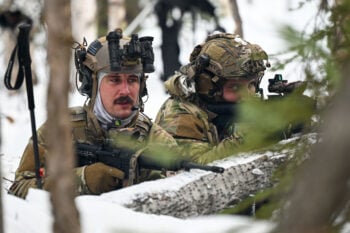
Incredibly precise optical clocks could revolutionize positioning, timing and navigation for both military and civilian uses. (DARPA image)
WASHINGTON: The Defense Department’s cutting-edge tech research agency is seeking industry partners to develop laser-based clocks that will be 100 times more accurate than today’s most precise models, while also small and rugged enough to be carried on Army vehicles and fighter jets.
If optical clocks can be made to work in the real world, said Tatjana Curcic, program manager for DARPA Robust Optical Clock Network (ROCkN) project, “I do think it will be revolutionary.”
“Optical precision timing techniques provide a means for orders of magnitude higher precision and accuracy, but, just as importantly, they enable more resilient timing capabilities with less reliance on GPS by virtue of longer holdover times and usage of optical signals that are more difficult to jam or spoof,” DARPA’s Broad Agency Announcement (BAA) for ROCkN, released Thursday, explains. (Holdover times means the length of time a timing signal stays accurate before it drifts and has to be corrected by another external signal.)
Military leaders, especially within the Army, have become increasingly fixated on finding alternatives to GPS, which is vulnerable to jamming and spoofing via false signals, in order to ensure positioning, timing and navigation in contested areas and during conflict.
Optical clocks rely on specialized lasers (i.e., not the little diode ones used in laser pointers to tease cats), rather than the microwaves used by today’s atomic clocks. While they have been shown to work in laboratories, current models are large and finicky, Curcic told Breaking Defense.
“The optical clocks today in the lab, they fill out a huge room, a big room with a very complex, very sophisticated apparatus that takes multiple PhDs to run,” she said. “So, getting that into a smaller, low power package that can run pretty much autonomously and continuously for a long time is a huge challenge.”
Doing so will require a “tradeoff” between extreme precision and usability, Curcic explained.
“Optical clocks in the lab are more than 100 times better than clocks and GPS. The optical clock that we are going to develop, we will definitely sacrifice some of the performance,” she said. “We are not aiming for the performance that folks have demonstrated in the lab. But still, it will be about 100 times or so better than current clocks.”
Another key challenge is reducing the size and power requirements of tools called “frequency combs” that “translate” from optical frequencies (300 GHz to 3000 THz) to microwave frequencies (from 1 GHz to about 100 GHz) that can be easily transmitted and used by all sorts of radio frequency-based devices, Curcic said.
The ROCkN program could lead to a potential future networked clock architecture for all military activities, but clock synchronization remains another challenge.
Today’s clocks use “RF techniques” for clock synchronization that don’t provide the level of superior precision optical clocks would, Curcic said. While the ROCkN project at the moment isn’t working on developing synchronization techniques, the agency hopes its work inspires future innovation.
“So once we have these clocks, one can start imagining really, with novel clock synchronization techniques, sort of new architectures for GPS-like constellations, and even not only in space, but on the ground as well,” Curcic said. “So I think this will inspire some work in clock synchronization as well … so that we can enable precision timing networks that can operate at much better precision — much higher precision than what we have today.”
Industry Requirements
DARPA’s BAA is asking industry to develop two types of prototypes with lower size, weight and power (SWaP) requirements, each designed for a different type of military mission.
Under Technical Area 1 (TA1), contractors will develop “high precision, small, portable clocks with aggressive SWaP and environmental sensitivity requirements designed for operation on mobile platforms.”
These prototypes should weigh less than five kilograms, use less than 25 Watts of power, and “demonstrate robustness against the environmental changes in acceleration, vibration, and temperature to enable clocks for airborne and spaceborne platforms such as tactical planes or satellites.” They also must “achieve sub-picosecond timing stability over short times” and a “10-day holdover of GPS-level timing precision,” which is about three nanoseconds.
Under TA2, vendors will “develop transportable clocks with long holdover and moderate SWaP and environmental sensitivity requirements designed for operation on more stable platforms.”
These should weigh less than 200 kilograms and use less than 400 Watts, and be “suitable for use in more stable platforms such as ships and land bases.” They will require only (only!) to maintain one nanosecond or better timing precision over one month, the BAA says.
“It is envisioned that TA2 clocks can serve as master clocks in a local or regional network,” the solicitation explains. “To be consistent with expected DoD use cases, these clocks should be able to operate autonomously (i.e., without manual human intervention) and near-continuously throughout a one-month campaign.”
Phase 1 of the development will run over 24 months; an optional Phase 2 another 24 months. DARPA intends to hold a virtual industry day for interested vendors on Feb. 3.
TAI exec claims 20 Turkish KAAN fighters to be delivered in 2028
Temel Kotil, TAI’s general manager, claimed that the domestically-produced Turkish jet will outperform the F-35 Joint Strike Fighter.


























